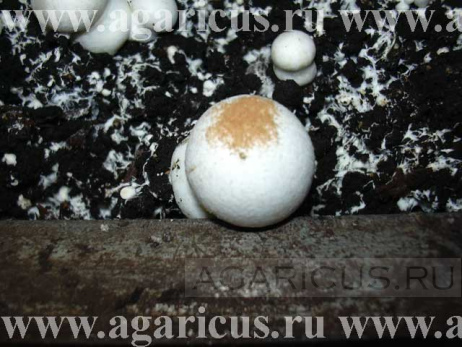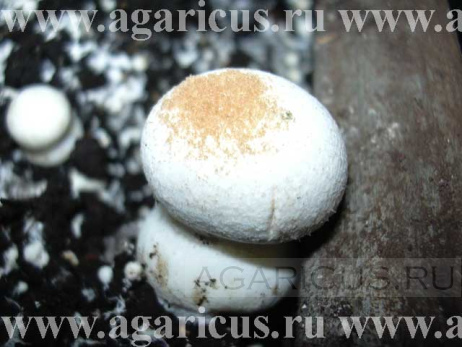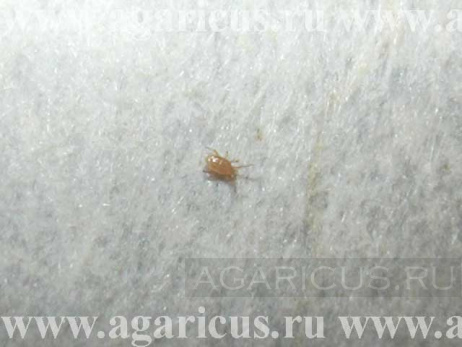Mites
Today, mites, like many other pests, rarely appear on farms where all technological parameters at preparation of compost and mushroom cultivation and also where strict hygiene is maintained.
Of all the mites that are encountered during the cultivation process, only a few kinds are counted as mushroom pests. Some mites feed on fungi and bacteria that exist in great amounts in decaying organic materials. The other members of this type of insects are predators that mainly feed on nematodes and smaller mites.
On the initial stage of composting, large populations of various mites might be found in the substrate, hence there’s nutrition for practically all species on this stage. But during the phase 1 compost preparation process and its pasteurization, all mites die. That is why the appearance of mites on a farm is an indication of either poorly prepared compost, or its inadequate pasteurization (in time and/or temperature conditions).
Moreover, mites can easily get inside the growing rooms if straw, manure or spent compost and mushroom wastes are kept very close to the farm.
Under unfavorable conditions some kinds of mites are able to take a specific shape, called "hypopus" and remain this way for a long period of time. In the hypopus state, the mite’s body flattens and gets covered with a thick shell that protects it from exposure. With the help of suckers, hypopus can adhere to moving objects such as flies or rodents and immigrate that way. When conditions favorable for the vital activity of mites are back, hypopus slough taking their usual appearance. Mites can get inside the growing rooms not only with flies, but by adhering to personnel’s clothes and footwear and/or implements.
The mites of Tarsonemus myceliophagus species that are considered mushroom pests are so small, that they are not seen with a naked eye. These shiny, light brown in color mites feed on the mushroom hyphae and the hyphae of many other competing fungi (olive green fungi, trichoderma and penicillium). Being present in great amount in the substrate, mites gnaw the bases of mushroom stipes, which in result become rounded and obtain a reddish-brown shade.
Despite the fact that unlike the majority of mites and insects, the mites of Tarsonemus myceliophagus species reproduce rather slowly (a female usually lays 1 egg in 24 hours within 3 weeks), the amount of damage they bring to the growing crop will depend on the time and degree of infection. If a large population of mites enters the batch at spawning, the consequences of their activities can be rather significant.
Red pepper mites (Pygmephorus species) got their names due to the outward appearance of their reddish-brown accumulations, moving on the mushroom caps or the casing surface.
Red pepper mite
Red pepper mite
These mites feed on competing fungi (generally on trichoderma), that is why their presence indicates poorly prepared compost. This kind of mites reproduce very fast, one female can lay up to 160 eggs within 5 days. And even though pepper mites are not mushroom pests, they promote the spreading of green molds not only in the infected room, but also in the whole farm. Moreover, being present in great amounts, they worsen the mushrooms’ marketable appearance and bring unpleasant sensations and sometimes even cause allergy for mushroom pickers at work.
In order to decrease the chances for the pepper mites to spread trichoderma, many mushroom growers treat the infected areas with gas burners and salt or tissue papers soaked in a disinfectant. But all these measures only hold back the fast increase of the mite population. The basic problem can be solved only at using high-quality compost.
Colorless and translucent saprophytic mites of Tyrophagus spp., Caloglyphus spp. and Histiostoma spp. species can sometimes be seen on mushrooms.
Unlike the species of mites described below, these mites are slightly bigger in size and slow-moving. Since mites feed on decaying vegetative remains, they only can be found in poorly prepared compost that isn’t well suited for mushroom mycelium growth.
Parasitus fimetorum, Digamasellus fallax and Arctoseius cetratus predator mites can be found in the growing rooms.
Red pepper mite
These mites are bigger in size and faster in movement than other mites. These predator mites feed on nematodes, smaller mites and the eggs and larvae of other mushroom pests. Therefore, they can be considered as helpful insects on different stages of mushroom cultivation. But on the other hand, the presence of predator mites indicates the presence of their source of food, that is, the more mites, the more other pests there are. This, in turn, means something went wrong during the compost preparation process and its pasteurization, and that there are some problems in the sanitary state of the farm.
Despite the fact that predator mites only benefit the mushrooms, they cause discomfort for the working personnel because they easily stick to clothes and hands, causing unpleasant sensations.
When predator mites appear, it is advised to test the whole batch of compost to detect their source of food and take measures against the real mushroom pests.
The general measures taken to prevent the appearance of all kinds of pests during the mushroom cultivation process could be the following:
Of all the mites that are encountered during the cultivation process, only a few kinds are counted as mushroom pests. Some mites feed on fungi and bacteria that exist in great amounts in decaying organic materials. The other members of this type of insects are predators that mainly feed on nematodes and smaller mites.
On the initial stage of composting, large populations of various mites might be found in the substrate, hence there’s nutrition for practically all species on this stage. But during the phase 1 compost preparation process and its pasteurization, all mites die. That is why the appearance of mites on a farm is an indication of either poorly prepared compost, or its inadequate pasteurization (in time and/or temperature conditions).
Moreover, mites can easily get inside the growing rooms if straw, manure or spent compost and mushroom wastes are kept very close to the farm.
Under unfavorable conditions some kinds of mites are able to take a specific shape, called "hypopus" and remain this way for a long period of time. In the hypopus state, the mite’s body flattens and gets covered with a thick shell that protects it from exposure. With the help of suckers, hypopus can adhere to moving objects such as flies or rodents and immigrate that way. When conditions favorable for the vital activity of mites are back, hypopus slough taking their usual appearance. Mites can get inside the growing rooms not only with flies, but by adhering to personnel’s clothes and footwear and/or implements.
The mites of Tarsonemus myceliophagus species that are considered mushroom pests are so small, that they are not seen with a naked eye. These shiny, light brown in color mites feed on the mushroom hyphae and the hyphae of many other competing fungi (olive green fungi, trichoderma and penicillium). Being present in great amount in the substrate, mites gnaw the bases of mushroom stipes, which in result become rounded and obtain a reddish-brown shade.
Despite the fact that unlike the majority of mites and insects, the mites of Tarsonemus myceliophagus species reproduce rather slowly (a female usually lays 1 egg in 24 hours within 3 weeks), the amount of damage they bring to the growing crop will depend on the time and degree of infection. If a large population of mites enters the batch at spawning, the consequences of their activities can be rather significant.
Red pepper mites (Pygmephorus species) got their names due to the outward appearance of their reddish-brown accumulations, moving on the mushroom caps or the casing surface.
Red pepper mite
Red pepper mite
These mites feed on competing fungi (generally on trichoderma), that is why their presence indicates poorly prepared compost. This kind of mites reproduce very fast, one female can lay up to 160 eggs within 5 days. And even though pepper mites are not mushroom pests, they promote the spreading of green molds not only in the infected room, but also in the whole farm. Moreover, being present in great amounts, they worsen the mushrooms’ marketable appearance and bring unpleasant sensations and sometimes even cause allergy for mushroom pickers at work.
In order to decrease the chances for the pepper mites to spread trichoderma, many mushroom growers treat the infected areas with gas burners and salt or tissue papers soaked in a disinfectant. But all these measures only hold back the fast increase of the mite population. The basic problem can be solved only at using high-quality compost.
Colorless and translucent saprophytic mites of Tyrophagus spp., Caloglyphus spp. and Histiostoma spp. species can sometimes be seen on mushrooms.
Unlike the species of mites described below, these mites are slightly bigger in size and slow-moving. Since mites feed on decaying vegetative remains, they only can be found in poorly prepared compost that isn’t well suited for mushroom mycelium growth.
Parasitus fimetorum, Digamasellus fallax and Arctoseius cetratus predator mites can be found in the growing rooms.
Red pepper mite
These mites are bigger in size and faster in movement than other mites. These predator mites feed on nematodes, smaller mites and the eggs and larvae of other mushroom pests. Therefore, they can be considered as helpful insects on different stages of mushroom cultivation. But on the other hand, the presence of predator mites indicates the presence of their source of food, that is, the more mites, the more other pests there are. This, in turn, means something went wrong during the compost preparation process and its pasteurization, and that there are some problems in the sanitary state of the farm.
Despite the fact that predator mites only benefit the mushrooms, they cause discomfort for the working personnel because they easily stick to clothes and hands, causing unpleasant sensations.
When predator mites appear, it is advised to test the whole batch of compost to detect their source of food and take measures against the real mushroom pests.
The general measures taken to prevent the appearance of all kinds of pests during the mushroom cultivation process could be the following:
- high-quality composting and compost pasteurization for the purpose of obtaining selective medium for mushroom mycelium;
- maintaining strict hygiene on the farm;
- Controlling flies and other mite spreaders;
- Thorough cleaning of all machinery, equipment and rooms that were used during the spawning process and spawn run;
- Steaming the rooms in the end of the cultivation cycle at necessary temperature, (it has to be made sure that the needed temperature level was reached in the whole growing room and in containers and shelves, to exclude any possibility for the mites to survive;
- Using disinfectants to clean all working surfaces and implements;
- Immediate removal of spent compost from the farm.




Lko:
Saheb hamare mushroom dry bable se pura form doob chuka hai ismein Ham Kya Karen Sahab Koi upay Ho to...
Production of Compost, Personal opinion (part 3). Wet...Abimbola Olaniyi-Balogun, Lagos Nigeria:
Hello there, I made mushroom compost using the long composting method. I used wet chicken manure, fresh...
Mushrooms in KazahstanZagreb, Croatia:
My name is Zlatko Vidmar.
Without chicken manure compost? Yes, it's possible...I am in modern mushroom growing over 40 years.
I see your farm and if...
nanyuki:
my email is samuelnjogo@gmail.com
Without chicken manure compost? Yes, it's possible...nanyuki:
i want to learn like a child on compost making for mushroom
Mushrooms in KazahstanVELLORE TAMILNADU INDIA:
SUITABLE JOBS – MUSHROOMS GROWER / COMPOST / SPAWN OR RELAVANT FIELDS
Without chicken manure compost? Yes, it's possible...Dear Hiring Manager...
Patna:
PLEASE SEND YOUR FORMULA without-chicken-manure-compost
watering first flush mushroomswasil, Malaysia:
i suggest you not to water on mush just maintain the good humidity if you not have any auto system for...
Compost Production. Personal opinion (Part 2)NARENDER SEHRAWAT, FARIDABAD NCR:
COMMON PROBLEM IN PHASE 1 BUNKAR IS THE UNBALANCED TEMERATURE, IT STARTS FROM 50-55 DEGREES TO 78-82...
Without chicken manure compost? Yes, it's possible...Hannes, Plettenberg Bay, South Africa:
Can you give me more details on compost without chicken manure for mushroom growing, what alternatives...